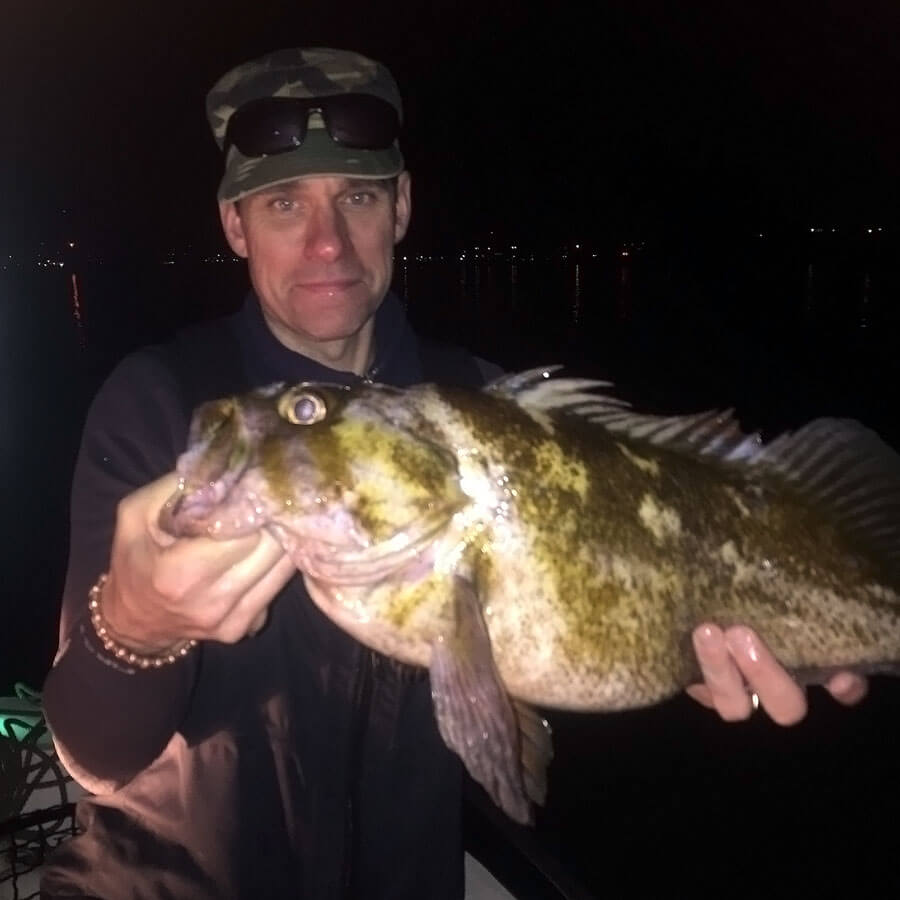I listened to my younger friends as we drove through Oregon’s coastal range toward the ocean. Nate and Jarod are biologists for the US Fish & Wildlife Service, Peter is a professor at a state university. Strong wind predictions and the younger men’s concerns—federal and state budget cuts, hectic work schedules, kids home sick, and frantic spouses—made me hope the trip would offer some relief. I glanced back at the boat we trailered, remembering past trips that buoyed our spirits during trying times.
For years we have enjoyed catching rockfish along the West Coast, dropping jigs into craggy lairs and kelpy crevices, or down through sonar-exposed schools below our boats. Members of the genus Sebastes, which means “magnificent” in Greek (and sometimes called “bass” by locals), the more than 75 species of Pacific rockfishes inhabit waters from Alaska to Baja California, and they make up an important part of the recreational and commercial fishery. But few people cast to them with flies.
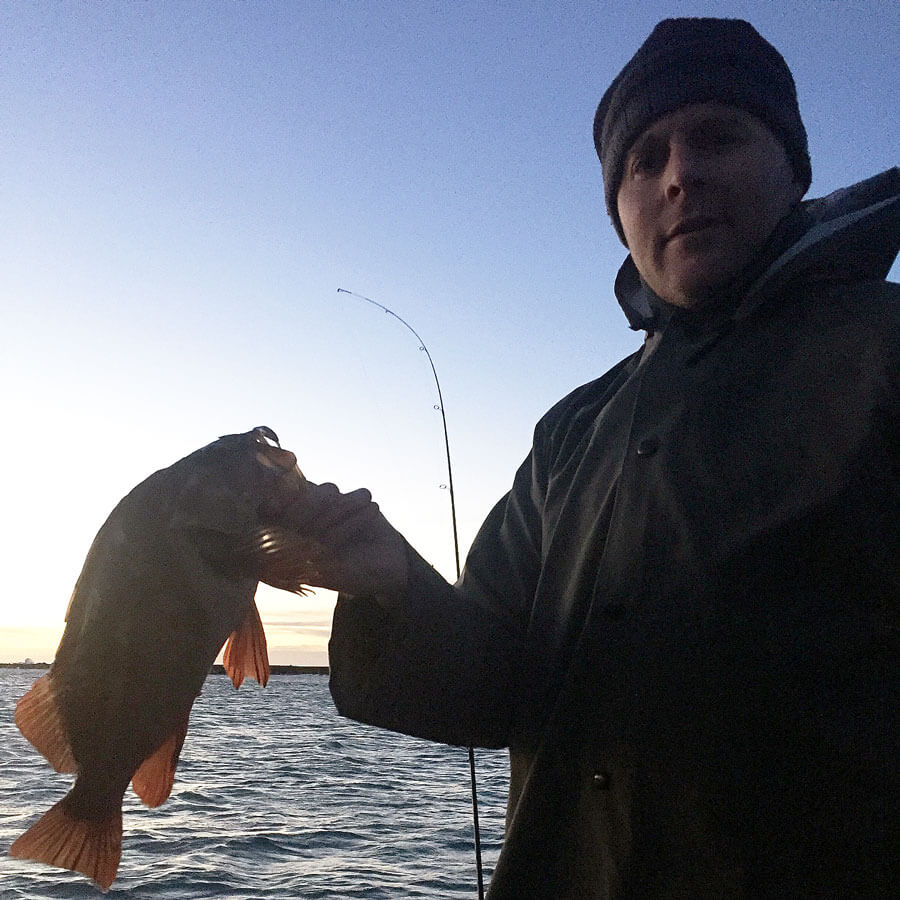 One summer afternoon, Peter and I were riding ocean swells on his 16-foot skiff, Kelson, when the surface began to boil with anchovies and the hearty splashes of pursuit. Peter had his 8-weight Cabela’s rod at the ready. He made a decent cast from the pitching bow, stripped the sinking line and pale streamer a couple of feet, and hooked a nice fish—maybe 4 pounds—that bent the rod, dove deep under the boat, and eventually came to my net. I freed the fly, and Peter sent out a second cast that immediately hooked another fish. This rockfish, much smaller, also shot straight for the bottom, attracting a large, fanged ling cod that trailed it to the surface. We thrilled over the 3-foot predator’s greenish glow, swimming inches behind the little rockfish, but sunlight and the lapping hull turned the beast away. We released the small rockfish and looked for more. Nothing. Then a huge splash behind us had me fumbling for the fly rod and shaking out some line. Peter laughed. I turned to see a pair of sleek porpoises arcing through the water.
One summer afternoon, Peter and I were riding ocean swells on his 16-foot skiff, Kelson, when the surface began to boil with anchovies and the hearty splashes of pursuit. Peter had his 8-weight Cabela’s rod at the ready. He made a decent cast from the pitching bow, stripped the sinking line and pale streamer a couple of feet, and hooked a nice fish—maybe 4 pounds—that bent the rod, dove deep under the boat, and eventually came to my net. I freed the fly, and Peter sent out a second cast that immediately hooked another fish. This rockfish, much smaller, also shot straight for the bottom, attracting a large, fanged ling cod that trailed it to the surface. We thrilled over the 3-foot predator’s greenish glow, swimming inches behind the little rockfish, but sunlight and the lapping hull turned the beast away. We released the small rockfish and looked for more. Nothing. Then a huge splash behind us had me fumbling for the fly rod and shaking out some line. Peter laughed. I turned to see a pair of sleek porpoises arcing through the water.
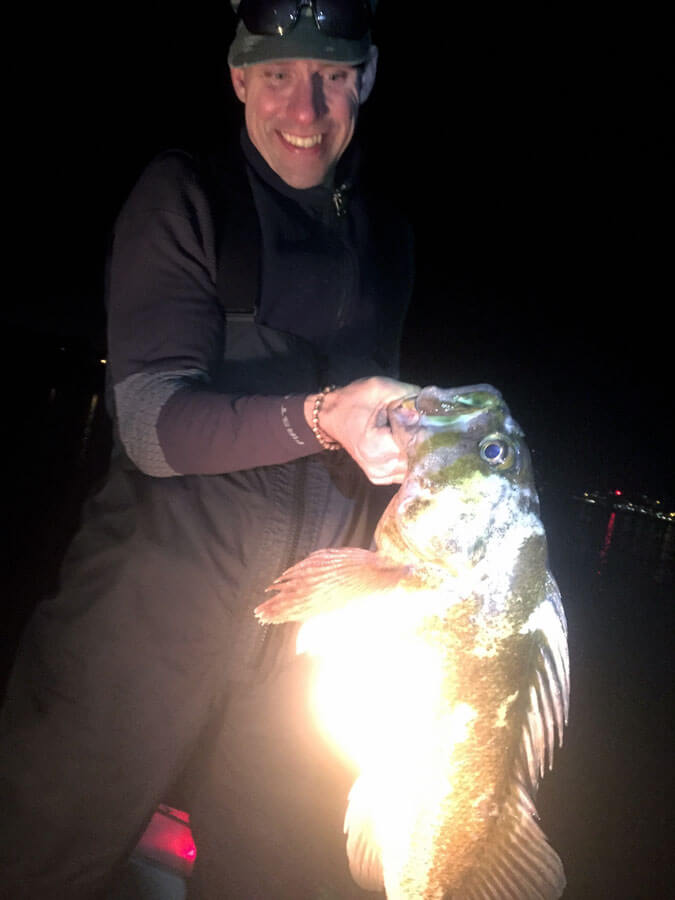 A surface flurry of rockfish happens only every once in a while on the ocean. Black rockfish, olives, yellowtails, and widows will come to the surface, but typically the fish are too deep to reach with flies. For small boat and shore anglers like us, however, stories of night fishing held special promise. Beginning in the 1970s, Oregon fly fishing maven, Richard Bunse, donned his miner’s helmet, a cord running down to the battery pack on his belt, and climbed over jetty rocks, casting streamers to eager rockfish. “The action at night was incredible,” Bunse said. “Nothing like what you’d experience during the day.” Legends also told of very big rockfish coming out under the cover of darkness. Many species of fish are nocturnal, hunting by glimpse, scent, and vibration. Normally wary brown trout boldly prowl the darkened shallows of rivers and lakes, snook gobble shrimp and smelt among the moon-dappled tropical mangroves, and striped bass and bluefish gorge on menhaden during warm nights along the Atlantic coast. Why don’t more fly anglers follow?
A surface flurry of rockfish happens only every once in a while on the ocean. Black rockfish, olives, yellowtails, and widows will come to the surface, but typically the fish are too deep to reach with flies. For small boat and shore anglers like us, however, stories of night fishing held special promise. Beginning in the 1970s, Oregon fly fishing maven, Richard Bunse, donned his miner’s helmet, a cord running down to the battery pack on his belt, and climbed over jetty rocks, casting streamers to eager rockfish. “The action at night was incredible,” Bunse said. “Nothing like what you’d experience during the day.” Legends also told of very big rockfish coming out under the cover of darkness. Many species of fish are nocturnal, hunting by glimpse, scent, and vibration. Normally wary brown trout boldly prowl the darkened shallows of rivers and lakes, snook gobble shrimp and smelt among the moon-dappled tropical mangroves, and striped bass and bluefish gorge on menhaden during warm nights along the Atlantic coast. Why don’t more fly anglers follow?
Night fishing can be challenging, even dangerous. Humans are creatures of light, and the older I get, the more illumination I need to tie knots, untangle leaders, and find my way over the water. Whether wading or navigating a boat, distance to objects appears distorted at night, rocks seem suddenly close, water and land melt together.
“Don’t worry. We’ll be careful,” I texted my wife, adding a piscine emoticon, as the possibility of large, feeding fish inside the bay took over our conversation in the truck. “I’d love to land a big one,” I blurted aloud. Jarod smiled, but reminded us that rockfish are slow-growing, long-lived creatures, often taking several years to sexually mature. This life cycle makes rockfish vulnerable to overfishing.
According to Dr. Milton Love of the Marine Science Institute at the University of California, Santa Barbara, several studies have shown an alarming decline in the number of older fish, whose offspring are more likely to survive than those of younger fish. According to Dr. Love, the black rockfish common off the Oregon coast can live into their 50s, and it takes them five years or more before they spawn. Yellowtail rockfish can live to be 65 years; canary rockfish, 85; quillback, 95. The ear bones of a 32-inch rougheye rockfish caught off Alaska showed it to be 205 years old. Although tarpon may live to be 60, redfish 40, and striped bass 30, bonefish and permit rarely exceed 20, and false albacore live no longer than five years. Rockfishes, along with the Greenland shark, Patagonian toothfish, and white sturgeon, are some of the oldest-living fish in the world.
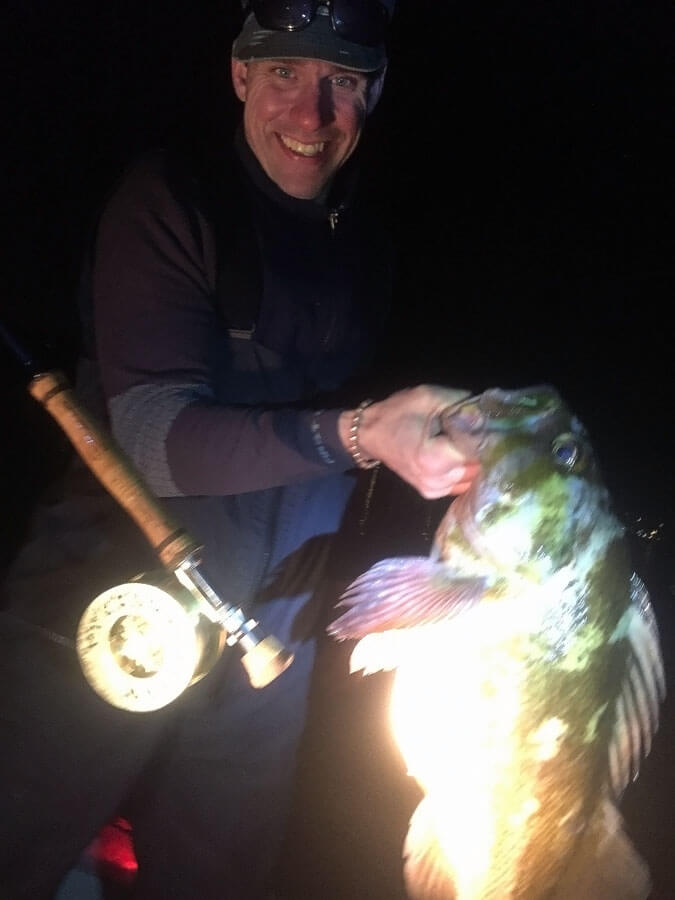 “If we catch a big rockfish,” Jarod proposed, “how about we let it go?” Jarod, a conservationist at heart, caught and released a 3-pound quillback on a previous trip, and the fish was on his mind. But angling lore warns against presumptuous planning, and this discussion felt a bit like a jinx, like sliding a big ice-filled cooler in the truck before a salmon trip, or snapping the net in place before the first cast. Then I remembered the Elizabeth Bishop poem about catching a “tremendous fish” that didn’t fight hard, but was “battered and venerable” with hooks and broken leaders trailing from his mouth “like medals with their ribbons.” The poem was written in 1946, long before catch-and-release was accepted practice, and yet staring at that big old fish hanging half out of the water, Bishop tells us—
“If we catch a big rockfish,” Jarod proposed, “how about we let it go?” Jarod, a conservationist at heart, caught and released a 3-pound quillback on a previous trip, and the fish was on his mind. But angling lore warns against presumptuous planning, and this discussion felt a bit like a jinx, like sliding a big ice-filled cooler in the truck before a salmon trip, or snapping the net in place before the first cast. Then I remembered the Elizabeth Bishop poem about catching a “tremendous fish” that didn’t fight hard, but was “battered and venerable” with hooks and broken leaders trailing from his mouth “like medals with their ribbons.” The poem was written in 1946, long before catch-and-release was accepted practice, and yet staring at that big old fish hanging half out of the water, Bishop tells us—
… victory filled-up
the little rented boat
from the pool of bilge
where oil had spread a rainbow
around the rusted engine . . .
—until everything
was rainbow, rainbow, rainbow!
And I let the fish go.
There’s always a bit of murky bilge water below the low transom of Peter’s 25-year-old Kelson, but her heavy, wide-beamed fiberglass hull is steady, even in a wind-whipped February bay like the one we crossed in the last hour of light. Hundreds of black surf scoter hugged the lee of a seawall, loons surfaced with small silver herring in their bills, and sea lions barked from a tilting green channel marker.
Approaching a barnacled point on the jetty, Nate readied the anchor, but a Coast Guard patrol drove down the road and waved us off. “Restricted bar,” the officer shouted through a bullhorn, and we retreated down channel and anchored off another stony knuckle that looked promising.
It’s impossible for four men to cast flies from a small boat, so we took turns at bow and stern, the chilly wind working for and against us as it blew hard off the ocean. After 30 minutes fishing the incoming tide, a red-freckled greenling gobbled up Nate’s scud. Then Jarod hooked a 10-inch copper rockfish, brilliantly patched in pink and orange. We put on our headlamps and kept at it, casting to the exposed rocks and retrieving through water ranging from 4 to 20 feet. Fishing was slow, but as darkness fell, so did the wind. The tide slowed, flooding close to high, and Peter caught a small black rockfish on a Lefty’s Deceiver. Peter is from the East Coast and he loves his Deceivers along with his old electric blue fly line with 30 feet of black 450-grain sinking head that has put him into countless striped bass from Maine to New Jersey. The line, kinked and worn, made it to Oregon for a few more years of service, and when I tell him it needs replacing, he says, “I love it, and know just how it sinks and responds.” I couldn’t argue because he was into a fish; so was I. The bite was on.
All of us were catching rockfish and an occasional greenling on flies. Most fish were in the 11-inch range, but a few larger fish up to 15 inches also came aboard. Peter changed to a smaller black Clouser and caught three fish in as many casts, including a gold-faced quillback with deeply notched dorsal spines. Rockfishing is often excellent at high slack tide, and darkness made it even better. As the tide turned and our boat swung on the falling water, Jarod hooked a large fish that bent his rod and ran for cover. “Damn,” he shook his head when the pulsing stopped. We were tempted to leave anchor and try to free the snagged fish, but the tippet broke. Soothing the loss of that big something, we savored the nearly windless winter night. Fish splashed all around us; and sea lions swam nearby, their vapored breath rising in puffs of fog visible before the harbor lights. Nate shined a powerful spotlight into the water, igniting the tinsel sides of herring dashing past.
We all took turns, catching close to 60 fish, toasting the bounty with a round of whisky and tender beef jerky. Dr. Love explains that “Day-night behavior of rockfish remains largely unstudied,” but “in deep water the fish are usually very quiet at night.” These shallow-water fish were clearly awake. Peter inspected the well-chewed Clouser under his headlamp—broken deer hair over the paint-chipped red eyes. “I’ve got some other steamers,” I offered.
“I’ll stick with this,” he said. “It’s working.”
The Clouser Deep Minnow was created in the late 1980s by Bob Clouser, a Pennsylvania angler and fly shop owner who sought a streamer for his beloved Susquehanna smallmouth. The late Lefty Kreh celebrated the Clouser in several articles and claimed to have used it to land over 80 species of fish. The lead dumbbell eyes allow the fly to drop quickly and ride hook-point-up, making it less snaggy. It may appear to be the fly angler’s version of the bucktail jig, but it was designed to swim in jerking horizontals. As Clouser himself describes, “The flat and narrow profile add to the movement of this fly dipping and darting when you strip it erratically.”
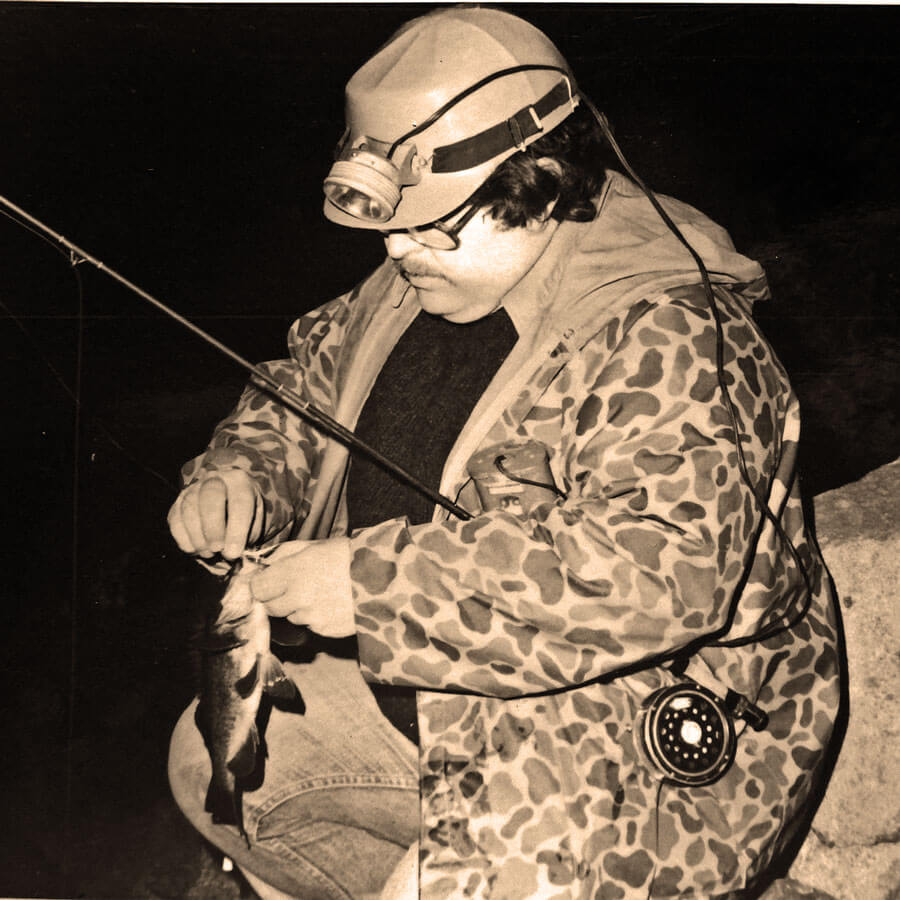 Peter resumed casting his Clouser from the bow, but rather than stripping erratically, he simply kept tension, letting the outgoing tide carry the now distressed streamer slowly over the bottom. “They’re taking it when it’s hardly moving,” he lifted another small fish out of the water. Young rockfish feed voraciously on bottom dwelling mysids, small crabs, and amphipods, as well as free-swimming krill and other plankton. After his next cast, Peter raised the rod, felt the resistance of something—a snag?—then stripped and set the hook into a large fish. “This is something, guys,” he smiled. The rod bowed deeply and pulsed; and though there was no great run, there was clearly a big fish pulling toward the rocks. Peter got the fish on the reel, applying considerable low angle pressure to keep it in open water.
Peter resumed casting his Clouser from the bow, but rather than stripping erratically, he simply kept tension, letting the outgoing tide carry the now distressed streamer slowly over the bottom. “They’re taking it when it’s hardly moving,” he lifted another small fish out of the water. Young rockfish feed voraciously on bottom dwelling mysids, small crabs, and amphipods, as well as free-swimming krill and other plankton. After his next cast, Peter raised the rod, felt the resistance of something—a snag?—then stripped and set the hook into a large fish. “This is something, guys,” he smiled. The rod bowed deeply and pulsed; and though there was no great run, there was clearly a big fish pulling toward the rocks. Peter got the fish on the reel, applying considerable low angle pressure to keep it in open water.
Anglers know the thrill of a big fish at the end of the line. Sometimes we’re fairly certain what it will be, but in salt water the mystery expands with every powerful pull and dive. After ten minutes, Peter had his big fish close to the boat. Nate provided a spotlight, Jarod held the net, and I readied for a photo. Suddenly there was the golden flash of a huge copper rockfish. Jarod lifted the net and the fish glistened in a marble swirl of brown, olive, and metallic yellow, a white streak running behind the gill plate and pectoral fins, its spiny dorsal high and fierce. Rockfish carry a mild venom in their dorsal spines, and Peter was once so painfully stung that I had to administer a first aid treatment of ice and rum. He carefully lifted this night’s fish with his Boga Grip scale—7 pounds even—approximately 22 inches. I took photos. We sounded off astonishment and praise. Victory filled up our little boat—and we let the fish go.
“I bet that was a world record,” Nate said.
“On the fly rod?” I qualified. “I bet you’re right.”
Consulting the International Game Fish Association website, we learned that the official all-tackle record for a copper rockfish is 7 pounds, 15 ounces, 22 inches, caught by Daniel Stamos, jigging a Diamond Bar in Shelter Cove, Humboldt County, California. Two state records (which do not supersede official IGFA records) for this species were set in the late 1980s: California, 8 pounds, 3 ounces; Washington, 10 pounds. There is no IGFA entry for a copper rockfish caught on a fly rod in any tippet class. Peter caught a world record.
I contacted the IGFA and inquired about an application, but it became apparent that we wouldn’t qualify. The IGFA encourages catch-and-release, but we did not get a weight from a certified scale, and we took no exact measurements. There are photos and witnesses, but the record remains in our memory and in the living leviathan that may be finning this very moment in his keply cave. “Once an adult finds a good reef, they don’t move around much,” Dr. Love told me during a phone interview. I sent the renowned ichthyologist a description and photo of our fish, and asked him to estimate the age. “That fish is just a little short of the maximum length, and because the maximum age thus far determined is 54 years old, the fish is likely in that range.”
I paused for a moment and said, “Like maybe, 52, my age.”
“Sure,” Dr. Love said. “Very possible.”
Bio: Henry Hughes grew up on Long Island, New York, and now lives in Oregon. He is the Oregon Book Award-winning author of four collections of poetry and the memoir Back Seat with Fish: A Man’s Adventures in Angling and Romance (Skyhorse Publishing, 2016). An active angler, naturalist, and literary critic, Henry edited the Everyman’s Library anthologies Art of Angling: Poems about Fishing and Fishing Stories. His work has appeared in Harvard Review, Antioch Review, Gray’s Sporting Journal, Anglers Journal, and Flyfishing and Tying Journal. Henry teaches at Western Oregon University.
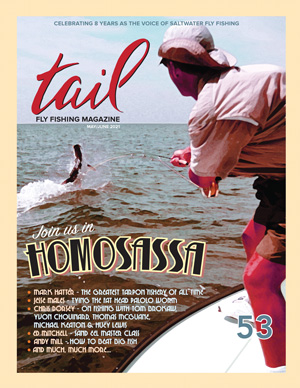 SUBSCRIBE TO TAIL FLY FISHING MAGAZINE
SUBSCRIBE TO TAIL FLY FISHING MAGAZINE

